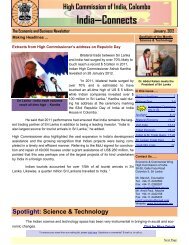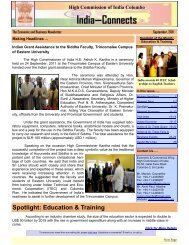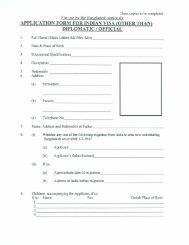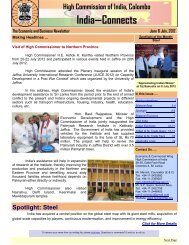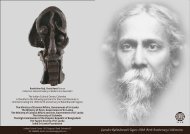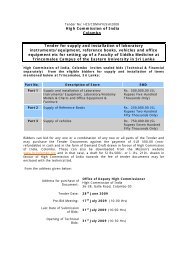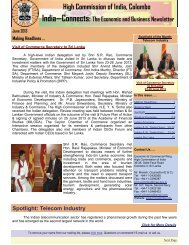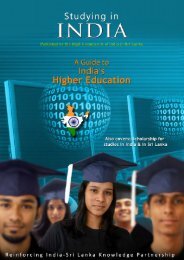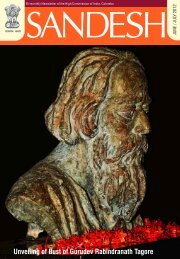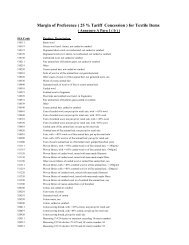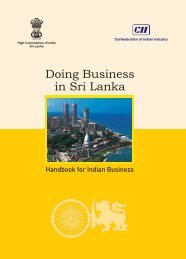Papers presented at the International Buddhist Conference, March ...
Papers presented at the International Buddhist Conference, March ...
Papers presented at the International Buddhist Conference, March ...
You also want an ePaper? Increase the reach of your titles
YUMPU automatically turns print PDFs into web optimized ePapers that Google loves.
of China political influence. Most of <strong>the</strong>m would be affected by<br />
major political dynamics which happened in China and India.<br />
Samudragupta assault in Gangga Valley dan South India in 400<br />
C.E., political expansion of Maharajas from Cola dynasty of<br />
Thanjavur in 1100 C.E., gave result in <strong>the</strong> eastern side of Benggala<br />
strait<br />
In a clearer sense, wh<strong>at</strong> is happening in China would affected<br />
Indian history. People of China would never <strong>at</strong> ease to see <strong>the</strong><br />
establishment of powerful countries in <strong>the</strong> sou<strong>the</strong>rn sea and it was<br />
worth to be considered th<strong>at</strong> <strong>the</strong> golden-age of Fu-nan, Cambodia,<br />
Java and Sum<strong>at</strong>ra Kingdoms were equal with <strong>the</strong> degener<strong>at</strong>ion<br />
time of major dynasties in China.<br />
In addition, Indian civilized countries were bonded with each o<strong>the</strong>r<br />
geographically and economically, and for each revolution in one of<br />
<strong>the</strong> countries would bring certain results for o<strong>the</strong>rs as well: <strong>the</strong><br />
disintegr<strong>at</strong>ion of Fu-Nan kingdom, <strong>the</strong> occurrence of Sriwijaya in<br />
Sum<strong>at</strong>era, Anawr<strong>at</strong>ha government in Pagan or Suryavarman II in<br />
Angkor, Thai Kingdom establishment in Sukhothai. All of those<br />
significant events were rel<strong>at</strong>ed with <strong>the</strong> geographical position of<br />
Sri Lanka as <strong>the</strong> anchor of South Asia who held gre<strong>at</strong> importance.<br />
For example <strong>the</strong> <strong>at</strong>tack to Sriwijaya by Cola kingdom was done<br />
through Sri Lanka harbor.<br />
The Cultural Flow: The Distinct and Profound<br />
To wh<strong>at</strong> extent did Hindu-<strong>Buddhist</strong> civiliz<strong>at</strong>ion absorbed into <strong>the</strong><br />
lives of Indochina and Nusantara people? Historians agree th<strong>at</strong><br />
under <strong>the</strong> Hindu-<strong>Buddhist</strong> civiliz<strong>at</strong>ion, people would still have<br />
<strong>the</strong>ir indigenous characteristic. At least th<strong>at</strong> wh<strong>at</strong>'s N.J. Krom said<br />
about Java. While Bali, according to W.F. Stutterheim, ”Hinduism<br />
since <strong>the</strong> start until present day would always be <strong>the</strong> culture of<br />
elites, but would never be <strong>the</strong> culture of <strong>the</strong> masses which are<br />
7<br />
bounded with Nusantara animism and worship to ancestors .<br />
Hinduism from <strong>the</strong> specific aspect of king worship as <strong>the</strong>y were in<br />
backside India are aristocr<strong>at</strong>ic religion by n<strong>at</strong>ure and never meant<br />
for masses. This explain why it is very easy and fast for people to<br />
accept Sri Lanka Buddhism and Islam to grow in <strong>the</strong> community,<br />
right <strong>at</strong> <strong>the</strong> time India got shocked by <strong>the</strong> conquest of Mongol and<br />
Islam <strong>at</strong>tack. The cultural influence of India was so gre<strong>at</strong> to <strong>the</strong><br />
extent <strong>the</strong>ir heritages can't be underestim<strong>at</strong>ed; we can see <strong>the</strong><br />
heritages are ranging from letters, most of <strong>the</strong> vocabularies, d<strong>at</strong>ing<br />
according to lunar and sun system, kosmogini myths which hardly<br />
never change, main stories in <strong>the</strong> Mahabar<strong>at</strong>a and Ramayana and<br />
Purana scriptures, several art formula, administr<strong>at</strong>ive and<br />
juridicition framework, <strong>the</strong> importance of social hierarchy which<br />
8<br />
is inherited from <strong>the</strong> caste system .<br />
People are tend to wonder th<strong>at</strong> in <strong>the</strong> regions very close with China,<br />
and have been engaged in trade and diplom<strong>at</strong>ic rel<strong>at</strong>ions for<br />
centuries, <strong>the</strong> China cultural influence means almost nothing,<br />
while in <strong>the</strong> Tongkin gulf and nor<strong>the</strong>rn Vietnam <strong>the</strong> influence was<br />
very strong. People are so impressed with <strong>the</strong> fundamental<br />
differences in result which occurred in far eastern countries by <strong>the</strong><br />
Chinasis<strong>at</strong>ion and Indianis<strong>at</strong>ion.<br />
The cause lay on <strong>the</strong> radical difference of colonialism methods<br />
which were used by <strong>the</strong> Chinese and Indian. Chinese act by<br />
conquest and seizure: soldiers conquer <strong>the</strong> country and <strong>the</strong>ir<br />
official spread Chinese civiliz<strong>at</strong>ion. The entrance of Hindu-<br />
<strong>Buddhist</strong> civiliz<strong>at</strong>ion in most of <strong>the</strong> time always done in peaceful<br />
manner and never to be followed by any destruction, like for<br />
9<br />
example Mongolian assault or America conquest by <strong>the</strong> Spanish .<br />
The N<strong>at</strong>ives were absolutely not being harmed or wiped out by <strong>the</strong><br />
conquerors, instead <strong>the</strong>y acquire from <strong>the</strong> Hindu-<strong>Buddhist</strong><br />
civiliz<strong>at</strong>ion which were tapped and conformed, a framework in<br />
which people <strong>the</strong>mselves could assimil<strong>at</strong>ed and developed. In <strong>the</strong><br />
o<strong>the</strong>r hand, Chinese always ask “<strong>the</strong> sou<strong>the</strong>rn barbarian”, for <strong>the</strong><br />
sake of <strong>the</strong>ir sovereignty, To be acknowledged through regular tax<br />
payment. Therefore, as <strong>the</strong> result Of this distinct approach <strong>at</strong> th<strong>at</strong><br />
time, Indianis<strong>at</strong>ion produced a profound impact comparable only<br />
10<br />
to th<strong>at</strong> Helenism in Middle Sea region .<br />
The Spread of Buddhism Civiliz<strong>at</strong>ion in Indochina and<br />
Nusantara<br />
The spread of Buddhism to Sri Lanka in <strong>the</strong> year of 300 B.C. was<br />
due to <strong>the</strong> main role of King Asoka's son who brought along <strong>the</strong><br />
relic of Buddha Gotama. He was welcomed by King Devanampiya<br />
Tissa (250-207 B.C.) who l<strong>at</strong>er on built Thuparama Dagoba for<br />
honoring Buddha's relic. Since <strong>the</strong>n, Sri Lanka Buddhism took a<br />
gre<strong>at</strong> role in <strong>the</strong> development of Indianis<strong>at</strong>ion and <strong>the</strong> <strong>the</strong> spread of<br />
Buddhism in South-East Asia.<br />
Until now, archaeological remains and Chinese sources point out<br />
th<strong>at</strong> <strong>the</strong> spread of Hindu-<strong>Buddhist</strong> civiliz<strong>at</strong>ion in Nusantara is as<br />
th<br />
old as in Malay Peninsula. In <strong>the</strong> first period of 5 century,<br />
according to Mulawarman inscription in Kalimantan and from<br />
11<br />
Purnawarman in Java , which was described by Fa-Hien after<br />
ninety days journey in <strong>the</strong> sea from Sri Lanka, and along with <strong>the</strong><br />
progression of diplom<strong>at</strong>ic rel<strong>at</strong>ion with China, an increase of<br />
indianis<strong>at</strong>ion occurred which could be considered if not because<br />
<strong>the</strong> spread of immigrant, <strong>at</strong> least it was due to <strong>the</strong> influence of<br />
cultural aspects, which from <strong>the</strong> available clues were probably<br />
origin<strong>at</strong>ed from Eastern or Sou<strong>the</strong>rn India. The l<strong>at</strong>er is considered<br />
12<br />
as <strong>the</strong> main influence but <strong>the</strong> role of Sri Lanka is not less<br />
13<br />
importance too .<br />
A record about <strong>the</strong> increase of indianis<strong>at</strong>ion in Java in 423 C.E. was<br />
describing <strong>the</strong> role of Monk from Kashmir, Gunavarman, a royal<br />
14<br />
family origin<strong>at</strong>ed . He came to Java from Sri Lanka, propag<strong>at</strong>ed<br />
Hinayana Buddhism and became <strong>the</strong> prime actor in converting<br />
King Vadhaka of <strong>the</strong> Java kingdom to Buddhism and consequently<br />
his kingdom thus making Buddhism as <strong>the</strong> religion for <strong>the</strong> whole<br />
kingdom. in o<strong>the</strong>r words, he convert Java itself to Buddhism into a<br />
<strong>Buddhist</strong> st<strong>at</strong>e. One time, King Vadhaka strongly aspired to<br />
become monk thus renounce his kingship. A predictable respond of<br />
protest from his ministers and subjects made him halt <strong>the</strong> radical<br />
decision yet with conditions which must be followed:<br />
1. Th<strong>at</strong> <strong>the</strong> venerable Gunavarman should be respected and<br />
obeyed throughout <strong>the</strong> length and breadth of his<br />
kingdom;<br />
2. Th<strong>at</strong> no living cre<strong>at</strong>ures should be killed throughout <strong>the</strong><br />
kingdom and this condition should be followed by all<br />
<strong>the</strong> subjects in his kingdom;<br />
3. Th<strong>at</strong> <strong>the</strong> wealth kept in <strong>the</strong> royal treasury should be<br />
distributed in charity among <strong>the</strong> sick, <strong>the</strong> poor and <strong>the</strong><br />
destitute.<br />
7<br />
Stutterheim, 1929, p.7<br />
8<br />
Cœdès, 1964, 64-5<br />
9<br />
St<strong>at</strong>ed by S.K Ch<strong>at</strong>terji (1936, p.87-96) and K.A Nilakanta Sastri (1946, p.18)<br />
10<br />
Groslier, 1961<br />
11<br />
It was st<strong>at</strong>ed by Fa-Hien in 414 C.E., he landed in an island called Ya-Wa-di after<br />
his bo<strong>at</strong> struck by storm. In his records, in <strong>the</strong> land of Ya-Wa-di no <strong>Buddhist</strong><br />
followers could be found and <strong>the</strong>re were only Brahmin priests<br />
12<br />
Stutterheim, 1929<br />
13<br />
Dupont, 1959a, p.631; 1959b, p.164-7; Casparis, 1961,p.241<br />
14<br />
Lal Hazra, 2007, p.844<br />
32



